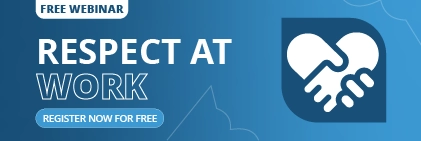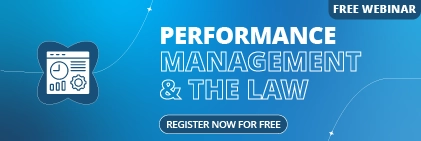Employee onboarding is designed to seamlessly integrate new hires into an organisation and its workplace culture. A well-structured onboarding process helps accelerate the adjustment to company systems and protocols, enabling new employees to rapidly transition into productive contributors within their teams.
What is employee onboarding?
Employee onboarding is a comprehensive, extended process that spans months, focusing on cultural integration, skills development, and relationship building. Unlike traditional orientation which typically covers basic company information in a single day, modern onboarding has evolved from a simple administrative task into a strategic process that can significantly impact productivity, retention, and employee satisfaction.
For Australian businesses navigating complex compliance requirements and diverse workplace regulations, effective onboarding ensures legal obligations are met whilst creating positive first impressions.
Whether you’re managing a small team in one state or scaling operations across Australia and New Zealand, strategic onboarding gives you a competitive advantage in building a high-performing workforce.
Why Good Onboarding Matters
Why invest in structured onboarding? The numbers speak for themselves. Research consistently shows that organisations with strong onboarding processes improve new hire retention by 82% and productivity by over 70%.
1. Cost Savings and ROI
Companies with effective onboarding programs often retain 90% of first-year employees compared to just 30% for organisations with poor onboarding experiences. The financial impact is substantial because research shows that replacing a single employee can cost between 50-200% of their annual salary when factoring in recruitment, training, and lost productivity.
2. Better Performance and Engagement
Well-onboarded employees reach full productivity 50% faster than those who experience poor onboarding. This translates to significant cost savings, particularly for Australian businesses where the average time-to-productivity can extend to 8-12 weeks for complex roles.
3. Faster Results
Strategic onboarding can reduce time-to-productivity by approximately:
- 25% for administrative roles
- 40% for technical positions
- 60% for senior leadership positions
4. Good vs Bad Onboarding Comparison
| Poor Onboarding | Effective Onboarding |
|---|---|
| 70% turnover in first year | 18% turnover in first year |
| 3-6 months to productivity | 6-8 weeks to productivity |
| Low engagement scores | 80%+ engagement rates |
| Higher recruitment costs | Reduced hiring frequency |
Note: these figures are approximate.
The investment in comprehensive onboarding systems and processes pays dividends through improved retention, faster productivity, and stronger cultural alignment.
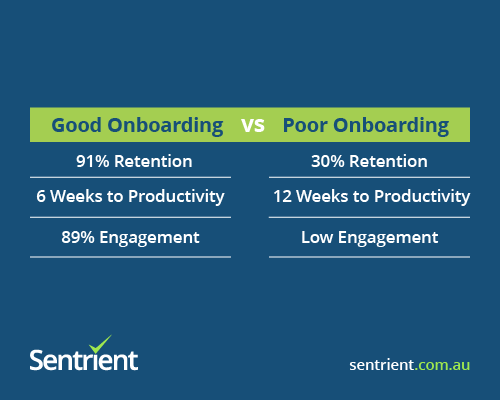
Essential Pre-boarding Elements
1. Send Welcome Messages:
Send personalised welcome messages within 24 hours of offer acceptance. Include practical information about parking, dress code, and first-day logistics alongside enthusiastic messaging about their upcoming role.
2. Handle Paperwork Early:
Streamline administrative tasks by sending digital forms, contracts, and compliance documents before day one. This allows new hires to complete paperwork at their convenience whilst ensuring all legal requirements are met.
3. Set Up Technology:
Prepare workstations, create email accounts, and configure system access in advance. For remote employees, ship equipment and provide detailed setup instructions to ensure seamless first-day experiences.
4. Tell the Team:
Brief existing team members about the new hire’s background, role, and start date. Encourage colleagues to introduce themselves and plan welcome activities that foster immediate connection.
Effective pre-boarding transforms nervous anticipation into genuine excitement whilst demonstrating your organisation’s professionalism and attention to detail.
The 5-Step Onboarding Process
How long should employee onboarding take? Research suggests optimal onboarding extends 12 months, with structured touchpoints at key intervals. Here’s how to structure your comprehensive onboarding journey:
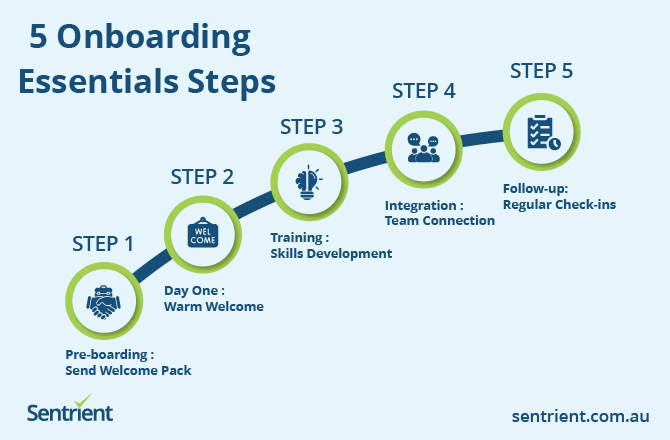
Phase 1: First Day Welcome (Days 1-3)
The first day sets lasting impressions. Focus on:
- Warm welcome and office tour
- Essential safety briefings and compliance training
- Technology setup and system orientation
- Introduction to immediate team members
- Clear explanation of first-week goals
Phase 2: First Week Setup (Days 4-7)
Build momentum with:
- Role-specific training commencement
- Manager one-on-one meetings
- Company culture immersion sessions
- Basic skill assessments
- Feedback collection on initial experiences
Phase 3: First 3 Months Learning
- 30 Days: Focus on foundational skills, relationship building, and initial project assignments.
- 60 Days: Expand responsibilities, introduce complex tasks, and conduct formal feedback sessions.
- 90 Days: Evaluate performance, set long-term goals, and plan career development pathways.
Phase 4: 6-Month Check-in
At the six-month mark, new hires should demonstrate full role competency. Use this phase for:
- Comprehensive performance reviews
- Career pathway discussions
- Advanced skill development planning
- Leadership opportunity identification
Phase 5: One-Year Success
The one-year milestone represents onboarding completion. Focus on:
- Achievement recognition and celebration
- Future goal setting and career planning
- Mentorship role preparation
- Long-term retention strategies
This structured approach ensures consistent development whilst allowing flexibility for individual needs and role requirements.
What Makes Onboarding Work
What makes onboarding truly effective? Six core components distinguish exceptional onboarding programs from basic orientation sessions:
1. Teaching Company Culture
Immerse new hires in your organisation’s culture through storytelling, value-demonstration activities, and regular culture-focused discussions. This goes beyond reading mission statements – it’s about experiencing your culture firsthand.
2. Clear Job Expectations
Provide detailed role descriptions, performance expectations, and success metrics. Unclear expectations are among the leading causes of new hire anxiety and early turnover.
3. Skills Training
Implement structured learning pathways that build capabilities progressively. Include both technical skills and soft skills development to ensure comprehensive growth.
4. Help Making Friends
Facilitate meaningful connections through buddy programs, team lunches, and informal networking opportunities. Strong workplace relationships significantly impact retention and job satisfaction.
5. Regular Feedback
Establish regular check-ins, feedback sessions, and open communication channels. New hires need frequent reassurance and guidance during their adjustment period.
6. Buddy/Mentor Program Structure
Pair new hires with experienced colleagues who can provide informal support, answer questions, and help navigate company culture. This relationship often becomes one of the most valuable aspects of the onboarding experience.
These components work synergistically to create comprehensive onboarding experiences that accelerate integration whilst building long-term engagement.
Using Technology for Onboarding
Why Use Automated Systems? Technology streamlines administrative tasks whilst ensuring consistency and compliance across all new hire experiences. Modern onboarding platforms integrate seamlessly with existing HR systems to create efficient, scalable processes.
Key Benefits of Automated Systems
1. Same Experience for Everyone
Automated workflows ensure every new employee receives the same high-quality onboarding experience, regardless of manager availability or departmental differences.
2. Easier Compliance
Digital systems maintain comprehensive audit trails, automatically track training completion, and ensure all legal requirements are met, particularly important for Australian businesses managing diverse compliance obligations.
3. Saves Time
HR teams save 40-60% of administrative time through automation, allowing focus on high-value activities like relationship building and strategic support.
Must-Have Software Features for Onboarding
Modern onboarding platforms should include:
- Digital document management and e-signatures
- Automated task assignments and reminders
- Progress tracking and milestone monitoring
- Integration with payroll and HR information systems
- Mobile accessibility for remote employees
- Reporting and analytics capabilities
For Australian businesses, ensure your chosen platform complies with local regulations and supports multi-state compliance requirements.
Creating Your Onboarding Plan
How do you structure effective onboarding workflows? Successful workflows break complex processes into manageable, sequential steps whilst maintaining flexibility for different roles and circumstances.
Before They Arrive Checklist
- Equipment and workspace preparation
- System access and security setup
- Documentation and contract completion
- Team notification and scheduling
- Welcome package preparation
First Day Checklist
- Personal welcome and introductions
- Workspace tour and facilities orientation
- Safety briefings and emergency procedures
- Technology setup and training
- Initial paperwork completion
Monthly Progress Guide
| Timeframe | Focus Areas | Key Activities | Success Measures |
|---|---|---|---|
| Week 1 | Orientation & Setup | Basic training, introductions | Comfort level, system access |
| Month 1 | Role Foundation | Skill building, goal setting | Task completion, feedback scores |
| Month 3 | Integration | Performance review, advancement | Productivity metrics, satisfaction |
| Month 6 | Consolidation | Advanced training, mentoring | Full competency, engagement |
| Year 1 | Mastery | Leadership development, planning | Career progression, retention |
This structured approach ensures consistent experiences whilst allowing customisation for specific roles and individual needs.
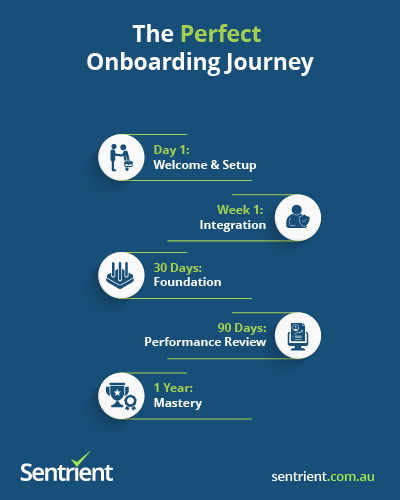
Industry-Specific Onboarding Considerations
Do different industries need specialised onboarding? Absolutely. Australian businesses across various sectors face unique challenges that require tailored onboarding approaches.
1. Healthcare and Compliance-Heavy Industries
Healthcare organisations and NDIS providers must prioritise:
- Extensive compliance training and certifications
- Patient safety and privacy protocols
- Clinical skill assessments and competency validation
- Regulatory requirement education
2. Technology and Fast-Paced Companies
Tech companies require:
- Rapid skill development programs
- Agile methodology training
- Innovation and creativity encouragement
- Technical tool proficiency development
3. Manufacturing and Safety-Critical Work
Manufacturing businesses emphasise:
- Comprehensive safety training and certification
- Equipment operation and maintenance protocols
- Quality control procedures
- Emergency response training
Understanding your industry’s specific requirements ensures onboarding programs address critical competencies whilst maintaining engagement and efficiency.
Remote and Hybrid Onboarding
How do you onboard remote employees effectively? Remote onboarding requires intentional design to overcome physical distance whilst maintaining personal connection and cultural integration.
Best Practices for Virtual Onboarding
1. Use Technology Well:
Utilise video conferencing, collaborative platforms, and digital tools to create interactive experiences that replicate in-person engagement.
2. Schedule Regular Video Calls:
Schedule regular video calls, virtual coffee chats, and online team meetings to maintain consistent connection throughout the onboarding period.
3. Build Culture Online :
Create virtual experiences that showcase company culture through online events, digital storytelling, and virtual team-building activities.
Remote Onboarding Technology Requirements
Essential tools include:
- Reliable video conferencing platforms
- Cloud-based document management systems
- Project management and collaboration tools
- Learning management systems for training delivery
- Communication platforms for ongoing support
Mixing Remote and In-Person (Hybrid Model)
Hybrid onboarding combines the best of both worlds:
- In-person experiences for culture building and relationship formation
- Virtual components for flexibility and efficiency
- Seamless transitions between remote and office-based activities
The key is maintaining consistency and quality regardless of the delivery method whilst accommodating different learning preferences and circumstances.
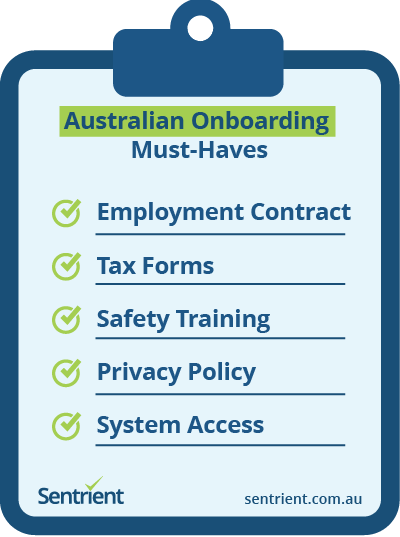
Legal Requirements and Compliance
What legal obligations must onboarding address? Australian businesses must navigate complex regulatory requirements whilst ensuring comprehensive compliance across all jurisdictions where they operate.
Employment Documentation and Verification
Essential Documentation Includes:
- Employment contracts and position descriptions
- Tax file number declarations and superannuation choice forms
- Fair Work information statements
- Workplace health and safety inductions
- Privacy policy acknowledgements
Safety Training and Certifications
All employees require workplace safety inductions covering:
- Emergency procedures and evacuation plans
- Industry-specific safety protocols
- Risk assessment and incident reporting procedures
- Personal protective equipment requirements
Industry-Specific Compliance Requirements
Different sectors have unique obligations:
- Healthcare: Registration verification, mandatory reporting training
- Financial Services: ASIC compliance, professional development requirements
- Construction: White card certification, site safety training
- Education: Working with children checks, mandatory reporting protocols
Record Keeping and Audit Requirements
Maintain comprehensive documentation including:
- Training completion records and certificates
- Compliance acknowledgement forms
- Performance review documentation
- Incident reports and corrective actions
Proper compliance management protects both employees and organisations whilst demonstrating commitment to legal and ethical operations.
Measuring Onboarding Success and ROI
How do you know if your onboarding is working? Effective measurement requires a combination of quantitative metrics and qualitative feedback to provide comprehensive insights into program effectiveness.
Key Performance Indicators (KPIs)
Retention Metrics (Who Stays vs Who Leaves):
- 90-day, 6-month, and 12-month retention rates
- Voluntary vs involuntary turnover analysis
- Cost-per-hire and replacement cost calculations
Productivity Measurements (How Fast They Learn):
- Time-to-productivity benchmarks
- Performance rating improvements
- Goal achievement rates
Engagement Indicators (How Happy They Are):
- Employee satisfaction survey scores
- Manager feedback ratings
- Peer integration assessments
Feedback Collection Methods
1. Regular Survey
Deploy brief surveys at 30, 60, and 90-day intervals to track satisfaction and identify improvement opportunities.
2. Group Discussions:
Conduct quarterly focus groups with recent hires to gather detailed qualitative feedback and suggestions.
3. Manager Reviews:
Provide structured evaluation forms for managers to assess new hire progress and integration success.
Continuous Improvement Framework
| Metric Category | Measurement Frequency | Target Benchmark | Action Triggers |
|---|---|---|---|
| Retention | Monthly | >85% at 90 days | <80% triggers review |
| Satisfaction | Quarterly | >4.0/5.0 rating | <3.5 triggers investigation |
| Productivity | Bi-annually | Meet role standards | Below standard triggers support |
| Compliance | Ongoing | 100% completion | Non-completion triggers follow-up |
Regular measurement and analysis enable data-driven improvements that enhance onboarding effectiveness over time.
Advanced Onboarding Strategies
What separates exceptional onboarding from standard programs? Advanced strategies personalise experiences, leverage technology innovations, and adapt to diverse workforce needs.
Making It Personal
Tailor onboarding based on:
- Role complexity and seniority level
- Previous experience and skill gaps
- Learning preferences and communication styles
- Career aspirations and development goals
Using Games and Fun
Implement engaging elements such as:
- Achievement badges and milestone recognition
- Interactive learning modules and quizzes
- Team-based challenges and competitions
- Progress tracking and visual dashboards
Multi-Generational Workforce Considerations
Different generations prefer different approaches:
- Baby Boomers: Structured, face-to-face interactions
- Generation X: Practical, efficiency-focused programs
- Millennials: Technology-enhanced, feedback-rich experiences
- Generation Z: Mobile-first, bite-sized learning modules
Cross-Cultural Onboarding for Global Teams
Address cultural diversity through:
- Language support and translation services
- Cultural sensitivity training for all team members
- Flexible accommodation for religious and cultural practices
- Inclusive communication and collaboration methods
Advanced strategies acknowledge that one-size-fits-all approaches limit effectiveness, whilst personalised experiences maximise engagement and outcomes.
Common Onboarding Mistakes and How to Fix Them
What mistakes derail onboarding programs? Understanding common pitfalls helps organisations avoid expensive errors whilst creating more effective experiences.
1. Too Much Information Too Fast
- Problem: Overwhelming new hires with excessive information in short timeframes.
- Solution: Distribute learning over extended periods using micro-learning approaches and just-in-time information delivery.
2. Lack of Structure and Planning
- Problem: Ad-hoc, inconsistent onboarding experiences across different managers and departments.
- Solution: Implement standardised workflows, clear timelines, and accountability measures for all stakeholders.
3. Poor Communication
- Problem: Inadequate communication between HR, managers, and teams leading to confusion and missed expectations.
- Solution: Establish clear communication protocols, regular check-ins, and centralised information management systems.
4. Not Enough Support
- Problem: New hires left to navigate challenges independently without adequate guidance or resources.
- Solution: Implement buddy programs, regular manager meetings, and accessible support channels.
5. Rushed Timelines and Unrealistic Expectations
- Problem: Pressure to achieve immediate productivity without allowing adequate adjustment time.
- Solution: Set realistic expectations, provide gradual increases in responsibility, and focus on long-term success rather than immediate results.
6. Technology and Access Issues
- Problem: System access delays, equipment problems, and technical difficulties creating frustration and productivity barriers.
- Solution: Complete all technical setup before start dates, provide comprehensive support, and maintain backup options for common issues.
Proactive identification and resolution of these common issues significantly improves onboarding success rates whilst reducing new hire anxiety and frustration.
Building a Great Onboarding Culture
How do you create organisation-wide commitment to exceptional onboarding? Building a culture of onboarding excellence requires leadership commitment, manager development, and continuous improvement focus.
Leadership Involvement and Commitment
Senior leaders must demonstrate onboarding importance through:
- Personal participation in welcome activities
- Resource allocation and investment decisions
- Regular program evaluation and improvement initiatives
- Success story sharing and recognition
Manager Training and Development
Equip managers with essential skills including:
- Effective feedback delivery and coaching techniques
- Cultural integration and relationship building
- Performance management and goal setting
- Problem identification and resolution
Team Participation and Ownership
Encourage broader team involvement through:
- Buddy program participation and training
- Welcome activity planning and execution
- Feedback provision and improvement suggestions
- New hire mentoring and support
Success Story Documentation
Capture and share success stories to:
- Demonstrate program value and impact
- Inspire continued excellence and innovation
- Identify best practices for broader application
- Build momentum for ongoing improvement
Creating a culture where everyone takes ownership of new hire success transforms onboarding from a HR responsibility into an organisation-wide commitment to excellence.
What’s Coming Next in Employee Onboarding
What’s next for employee onboarding? Emerging technologies and changing workforce expectations are reshaping how organisations approach new hire integration.
1. AI and Machine Learning Applications
Artificial intelligence enables:
- Personalised learning path recommendations
- Predictive analytics for onboarding success
- Automated content curation and delivery
- Intelligent chatbots for 24/7 support
2. Virtual and Augmented Reality Training
Immersive technologies offer:
- Realistic simulation-based learning experiences
- Safe practice environments for high-risk procedures
- Enhanced engagement and retention rates
- Standardised training delivery across locations
3. Micro-Learning and Bite-Sized Content
Modern learners prefer:
- Short, focused learning modules
- Just-in-time information delivery
- Mobile-optimised content formats
- Spaced repetition for improved retention
Staying ahead of these trends positions Australian businesses to attract top talent whilst providing cutting-edge onboarding experiences that set new standards for excellence.
How to Get Started
Where do you start with onboarding improvement? A structured implementation approach ensures successful transformation whilst minimising disruption to existing operations.
Phase 1: Check What You Have Now (Weeks 1–2)
- Audit existing onboarding processes and documentation
- Survey recent hires and managers for feedback
- Identify compliance gaps and improvement opportunities
- Benchmark against industry best practices
Phase 2: Set Goals and Plan (Weeks 3–4)
- Define specific improvement objectives and success metrics
- Allocate resources and assign project responsibilities
- Develop timeline with realistic milestones
- Secure leadership commitment and support
Phase 3: Build New Process (Weeks 5–8)
- Create new workflows, templates, and documentation
- Develop training materials and resources
- Configure technology systems and integrations
- Prepare communication and change management plans
Phase 4: Test It Out (Weeks 9–12)
- Implement pilot program with select new hires
- Gather feedback and make iterative improvements
- Train managers and support staff
- Refine processes based on pilot results
Phase 5: Launch for Everyone (Weeks 13–16)
- Launch organisation-wide implementation
- Monitor progress and address issues promptly
- Collect feedback and measure success metrics
- Celebrate successes and recognise contributions
Phase 6: Keep Improving (Ongoing)
- Regular program evaluation and updates
- Stay current with industry trends and best practices
- Maintain stakeholder engagement and commitment
- Scale successful practices across all locations
This systematic approach ensures sustainable change whilst building capability for ongoing excellence.
Conclusion: Make Your Onboarding Better
Strategic employee onboarding is a competitive necessity, not an option. Companies with effective onboarding programs achieve 82% higher retention rates and 70% faster productivity gains – delivering measurable ROI whilst building stronger workplace cultures.
Sentrient’s integrated HR and compliance platform streamlines onboarding for Australian businesses, ensuring regulatory compliance whilst automating administrative tasks. From digital document management to comprehensive training delivery, our Australian-designed solution transforms onboarding into a strategic advantage.
Don’t let poor onboarding cost you talent and productivity. Ready to revolutionise your process? Discover how Sentrient can help you build exceptional onboarding programs that drive real results.
Frequently Asked Questions (FAQs)
1. What’s the difference between onboarding and orientation?
Orientation is a short-term introduction to basic company information, whilst onboarding is an extended strategic process focusing on integration, development, and retention.
2. How much should companies invest in onboarding?
Best-practice organisations typically invest 1–3% of total salary costs in onboarding programs, with ROI delivered through improved retention and faster productivity.
3. What are the most common onboarding mistakes?
Information overload, lack of structure, poor communication, insufficient support, rushed timelines, and technology issues are the primary failure points.
4. How do you measure onboarding success?
Track retention rates, time-to-productivity, employee satisfaction scores, manager feedback, and compliance completion rates to measure program effectiveness.
5. What technology is essential for modern onboarding?
HR management systems, learning management platforms, digital document management, video conferencing, and mobile-accessible tools are fundamental requirements.
6. How do you onboard remote employees effectively?
Use video conferencing, digital collaboration tools, structured virtual touchpoints, online culture activities, and technology-enhanced engagement to replicate in-person experiences.
7. What legal requirements must be considered?
Employment documentation, tax and superannuation forms, safety training, privacy acknowledgements, and industry-specific compliance requirements must be addressed.
8. What role do managers play in successful onboarding?
Managers are critical for relationship building, expectation setting, performance feedback, cultural integration, and ongoing support throughout the onboarding journey.
